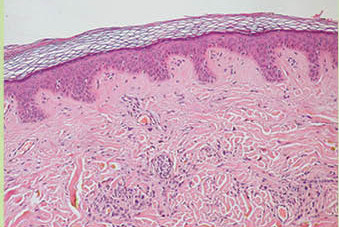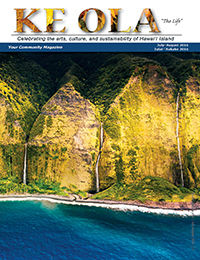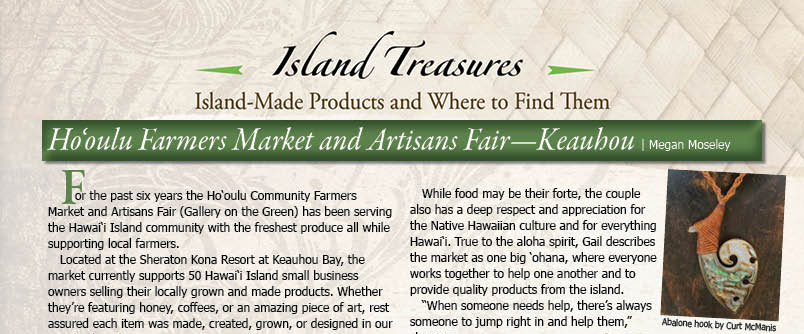
Ke Ola Pono: Ka ‘Ili (the skin)
 By Leilehua Yuen
By Leilehua Yuen
Whatever we may believe to be the causes, climate change is here.
When I was a girl, Mauna Kea was blanketed in snow from about Thanksgiving to Easter. On chilly days, girls would wear t-shirts or turtlenecks under their mu‘umu‘u. Paper parasols were only about $3 at the shops downtown, so on rainy days, the smell of the oil with which they were waterproofed filled the air.
Sometime in August–September there would be several weeks of drought. People would conserve water, doing things like washing dishes in a pan, saving the water, and then pouring the dishwater in the garden to water the plants. We rubbed ourselves with baby oil and laid out to “get a good healthy tan.” Those, like me, who were very fair, added a bit of iodine to the oil to enrich the color.
Meanwhile, our mothers, grandmothers, and auntys scolded that we were cooking our skin and would soon look wrinkled and old. Instead of listening, we soaked cotton balls in lemon juice or hydrogen peroxide and rubbed it on strands of hair to get the sunstreaked look of California. Hair stylists convinced us that beauty lay in thinning and layering our locks.
Now, we compare notes on our basal cell carcinoma treatments and look for products to darken and thicken our hair!
Times have changed, indeed. The Makahiki rains are no longer as regular as they once were. The end of summer droughts now last years in some areas. Hurricane season, once primarily of concern to boaters, is getting more violent and has caused extensive damage in the past several years.

Our pastime of laying out to “get a good healthy tan” is now known to be not healthy at all. According to the Skin Cancer Foundation, more people develop skin cancer because of tanning than develop lung cancer because of smoking, and itʻs getting worse.
So, what do we do if we want beautiful skin? Well, for ola pono (good health), I think the first step is to understand that beauty is not a specific color or shade of skin, rather that beautiful skin is healthy skin. Lively glowing skin filled with moisture, skin that moves smoothly when the muscles beneath it move, that is beautiful skin.
Our skin works hard for us, and deserves all the support we can give it. It is the largest organ of the body. Among its many functions, it is a wrapper that keeps our body fluids in and prevents us from dehydrating. The skin, itself, can become dry if its surface is exposed too much to wind, sun, and water. To keep it hydrated, drink plenty of water and after bathing, while the skin is still damp, use a body oil to help seal moisture into the skin. I am a fan of organic coconut oil, use what works best for you.
Not only does skin keep things in, it also keeps things out. Bacteria, dirt, UV radiation all are kept out of our more vulnerable tissues by our hard working skin. A thick acid mantle helps to keep bacteria at safe levels. Melanin goes into production when we are exposed to ultraviolet light. If this amazing package we are wrapped in is damaged or torn, it immediately starts repairing itself. In order to help it do these things, we need to eat a balanced diet with sufficient proteins, minerals, and vitamins. Using sunscreen, or wearing garments that keep sunlight off the skin also help it do its job. For those of us who must get our sun fix, morning and evening, when the rays are longer, are the least damaging.
Our skin also works hard manufacturing chemicals, which keep the cells regenerating. It is an amazing solar collector, taking the light which bathes it, and converting it to Vitamin D, sending that to the liver and kidneys to be converted into useable forms which regulate bone growth, cell growth, and our immune system, among other things. Eating healthful foods with anti-inflamation properties is supportive, and we can reduce stress on the skin by avoiding unhealthful foods.
The skin is also a complex data collection system. Its nerves gather information on humidity, temperature, pressure, size of pressure points (we can generally tell the difference between being poked with a pencil and with a pin), and wind direction. It sends the information it has collected to the brain, which then directs it to cool us by sweating and increasing blood flow to the surface (hence red faces on hot days), or directs it to shrink the surface blood vessels, reduce blood flow, and retain heat in the body.
Lomilomi can support our skin’s function by stimulating it, increasing the production of serotonin, dopamine, and oxytocin. Exercise also supports the skin by toning the underlying muscles and increasing perspiration, which helps remove toxins.
Summing it up, the basics to support your skin for beauty and health:
- Drink lots of water
- Keep your skin clean
- Seal in moisture
- Protect it from the sun
- Exercise
- Stimulate it through lomilomi/massage
Contact writer Leilehua Yuen


